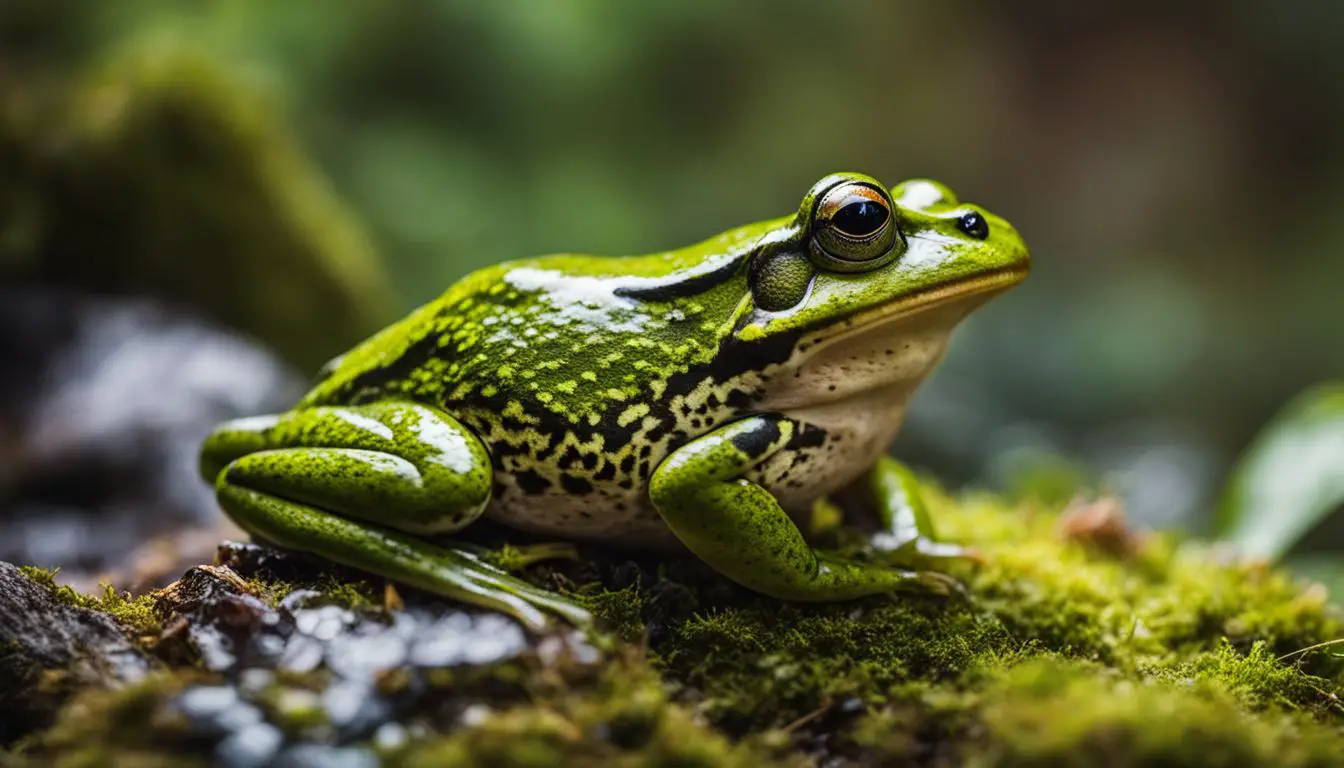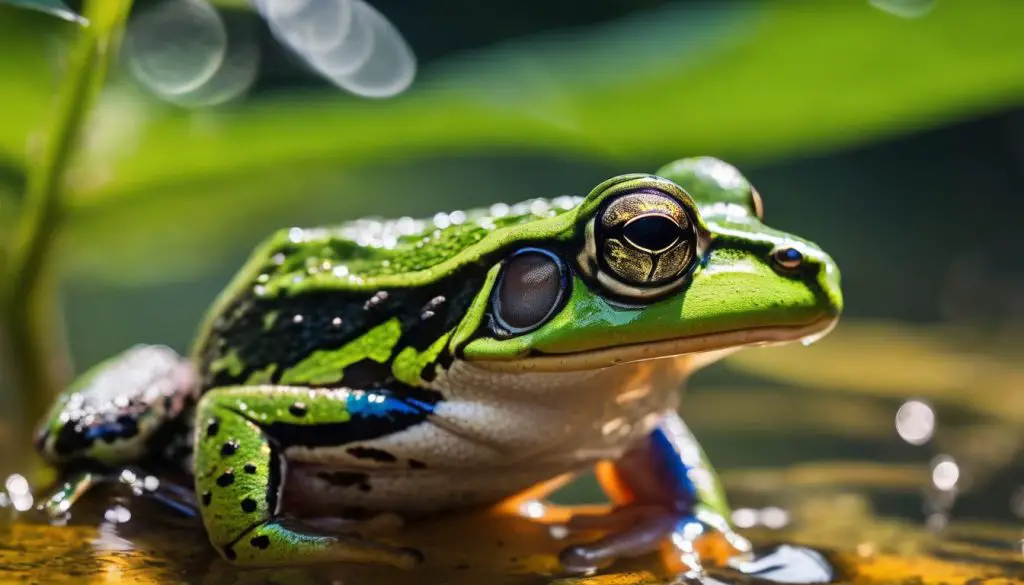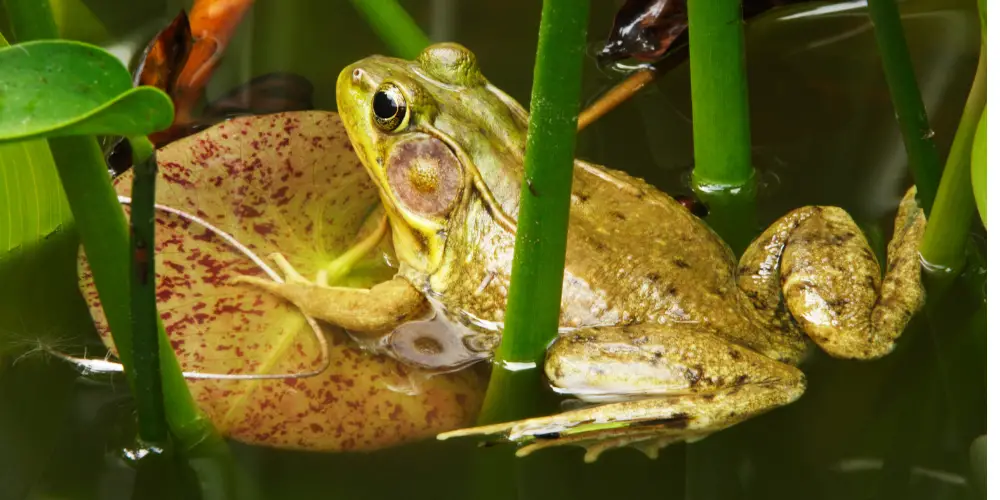As we explore our backyards or stroll through local parks, it’s easy to overlook the tiny creatures hopping by our feet. Amphibians, like frogs and salamanders, are often unseen heroes maintaining the balance of nature.
This blog will dive into their world, revealing how these humble critters keep ecosystems thriving and what we can do to protect them. Get ready for a leap into the fascinating role of amphibians!
Definition and Types of Amphibians
Amphibians are fascinating creatures that have evolved to live on land and water. The journey of these animals begins as aquatic tadpoles, breathing through gills before they undergo metamorphosis into adults with lungs for air intake.
This remarkable transformation sets them apart in the animal kingdom, showcasing their unique ability to exploit different ecological niches during their life cycle.
Frogs and toads are among the most recognized amphibiansfor their jumping abilities and vocal calls. Salamanders, including newts, prefer a quiet life hidden under logs or stones near moist environments.
Caecilians remain elusive due to their underground habitat—they’re legless amphibians resembling giant worms or snakes. Each type plays a crucial role in ecosystem balance, from controlling insect populations to being prey for other wildlife.
The diversity within this group reflects nature’s complexity; some use vibrant colors to warn predators of toxicity like poison dart frogs do, while others show muted tones as camouflage in leaf litter.
Exploring further into the lives of these adaptable vertebrates allows us insight into how ecosystems function and why preserving each species is vital—leading us next to understanding their roles within those systems.
Role of Amphibians in Ecosystems
Amphibians are crucial players in maintaining the delicate balance of our ecosystems, serving as both predators and prey that influence the dynamic web of life. Their presence shapes food chains and drives vital processes like nutrient cycling, impacting everything from soil quality to plant growth.
Secondary Consumers in Food Chains
Frogs, salamanders, and newts step into the spotlight as crucial secondary consumers within various food chains. Their appetite for insects and other small creatures helps keep pest populations in check.
This role is vital because it curtails potential disease carrier outbreaks like mosquitoes and maintains a harmonious energy flow among living organisms in ecosystems.
As these amphibians hunt and feed, they become nourishment for a diverse array of predators themselves. Birds swoop down to snatch them up, while fish see them as aquatic snacks, demonstrating the interconnected layers within our environment’s food web.
By serving both roles—hunter and hunted—they contribute significantly to ecological balance by actively participating in nutrient cycling and ecosystem services that benefit terrestrial and aquatic habitats.
Impact on Nutritional Cycling

As secondary consumers, amphibians are instrumental in energy flow through food chains that underpin nutrient cycles. They consume many pest species and organic matter, breaking them into simpler forms that enrich soils.
This process fuels plant growth, creating a loop where nutrients are continuously recycled between flora and fauna.
Amphibians also prey for diverse predators, distributing these vital nutrients throughout ecosystems. When they pass away, their bodies contribute to the decomposition cycle, returning valuable nitrogen to the soil and aquatic systems.
This natural cycle promotes stronger vegetation and supports overall ecosystem resilience. By maintaining such fundamental processes, amphibians prove essential in keeping ecological balance beyond mere population control—they are key players in Earth’s intricate game of nutrient cycling.
Ecosystem Services Provided by Amphibians
Amphibians play a surprisingly versatile role in supporting the natural world, offering various ecosystem services that benefit both wildlife and humans. From acting as indicators of environmental health to contributing to medical breakthroughs, these creatures are pivotal in maintaining ecological balance and advancing scientific knowledge.
Provisioning
Amphibians play a crucial role in ecosystem provisioning by supplying various natural services. Their unique skin glands produce proteins with antimicrobial activity, essential for developing new antibiotics and medicinal products.
These substances have already made significant contributions to pharmaceuticals, such as epibatidine—a compound that is hundreds of times more powerful than morphine for pain management.
Beyond their biochemical gifts, amphibians also help maintain healthy environments through diet. By feeding on pests like flies and mosquito larvae, they act as natural biological controls in agricultural settings.
This pest management supports crop diversity and food supplies while reducing the need for genetically modified plants or intensive use of pesticides. Thus, these diverse creatures protect human health through potential medical breakthroughs and enhance sustainable farming and agriculture practices.
Regulating
Amphibians serve as natural pest controllers in many ecosystems. They feast on agricultural pests and insects, keeping populations in check and helping to maintain a healthy balance.
This action is vital for crop health and reduces the need for chemical pesticides that can harm the environment. Frogs, newts, and salamanders consume vast quantities of mosquitoes, which helps control diseases these insects might carry.
Their role extends beyond just pest control; amphibians are important biological control agents regulating disease spread in other species. These creatures support ecosystem health by preying on hosts of endoparasites like trematodes or helping manage invasive species by consuming their larvae or eggs.
Moreover, their skin harbors unique antibacterial properties, providing insights into developing new medicines. Amphibians contribute significantly to maintaining ecological equilibrium and human well-being through such diverse regulating roles.
Cultural Services
Amphibians enchant us with their diverse colors and behaviors, cultivating a sense of wonder in the natural world. Many cultures hold these creatures in high regard, featuring them in myths, folklore, and art.
Their intriguing life cycles from water to land inspire educational stories and important environmental lessons for all ages.
Not only do amphibians play vital roles as secondary consumers in food chains and nutrient cycling within ecosystems, but they also contribute to our cultural enrichment. In regions like Central America’s Tortuguero National Park or the vast wetlands of the Amazon, local traditions often evolve around species like the vibrant coqui frog or the elusive pods.
These unique animals become symbols of nature’s beauty and complexity, fostering a deep appreciation for biodiversity that drives conservation efforts at various scales—from small community projects to international movements striving to protect endangered species.
Amphibian Conservation and Its Importance in Ecosystems

Protecting amphibians is not just about saving these remarkable creatures; it’s a vital step in maintaining the balance of ecosystems worldwide. These animals act as predators and prey, keeping insect populations in check and providing food for birds, mammals, and reptiles.
Conservation efforts focus on preserving natural water and organic soil sources that amphibians need to survive. Habitat degradation from pollution or development can devastate their delicate respiratory systems since many breathe through their skin.
Initiatives to safeguard diverse species like urodela (salamanders) and anuran (frogs) improve ecosystem restoration outcomes. Their presence encourages energy flow in ecosystems by participating in processes such as bioturbation – the mixing of soil layers by living organisms – which enhances soil fertility necessary for plant growth.
This diversity also supports nutrient cycling essential for healthy aquatic ecosystems where many amphibians live part-time or throughout their life cycle. Keeping these amphibian populations thriving ensures mutualistic interactions continue to bolster ecological resilience against disturbances like climate change.
The Role of Salamander Habitats in Preserving Biodiversity

Salamander habitats are hotspots for species diversity, teeming with life forms from insects to plants. These environments create a complex web of interactions where salamanders contribute significantly.
They manage invertebrate numbers and provide meals for predators, keeping ecosystems in balance. Moist forests and streams typical of these habitats support many organisms that might not survive elsewhere.
Maintaining these specialized ecosystems is vital as they serve as a natural laboratory for studying ecological relationships. Salamanders breathe through their skin, requiring pristine conditions free from pollution; hence, conserving their habitats helps protect water quality for other species.
A healthy salamander population signals a biologically diverse and functioning habitat — essential in preserving our planet’s rich tapestry of life.
As stewards of the Earth, efforts to safeguard salamander-rich regions also shield countless other creatures, highlighting the interconnected nature of biodiversity conservation. Moving forward into amphibian conservation, we consider how protecting our slimy friends has broader ecosystem implications.
Conclusion
Amphibians may be small, but their impact on ecosystems is mighty. They are vital in keeping insect populations in check and contributing to nutrient cycles that nourish our planet.
Their presence indicates the environment’s health, urging us to address conservation urgently. As we strive to protect these creatures, we safeguard the biodiversity essential for a stable and thriving ecosystem.
Let’s recognize their significance and advocate for sustainable practices that ensure their survival — our world truly depends on it.
FAQs
1. Why are amphibians important for ecosystems?
Amphibians play a key role in ecosystems by aiding in nitrogen cycling, pollinating flowers, and controlling insect populations like flies.
2. Can amphibians breathe through their skin?
Yes, many amphibians can absorb oxygen directly through their moist skin, which is essential for survival, especially for species that live on land and in water.
3. What kinds of foods do amphibians eat?
While some are herbivorous, eating plants and fruits, others have a diet that includes insects or small animals. Species such as the mountain chicken frog are known to be frugivores consuming mostly fruits.
4. Are all amphibian species safe to handle due to possible toxins?
No, it’s best not to touch them; some secrete substances like alkaloids from their skin as defense mechanisms against predators, which could be harmful if ingested.
5. How does intensive agricultural activity affect amphibian populations?
Intensive agriculture can harm habitat diversity and quality, leading to declines in amphibian populations through pollution with chemicals like nicotine or potassium pesticides.
6. Do people keep wild amphibians as pets?
Yes, the pet trade includes some varieties of exotic amphibians; however, certain practices can stress wild populations, so conservation efforts recommend responsible pet ownership.



